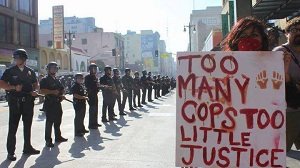 Recent tragedies involving police officers killing unarmed blacks, like the ones that happened in Baltimore and Cleveland, have attracted a great deal of public attention – both to the events themselves and to what many perceive as an epidemic of police brutality. It seems to sweep over the United States and there is an opinion that police brutality, as it is often stated, is aimed primarily at people of color.
Recent tragedies involving police officers killing unarmed blacks, like the ones that happened in Baltimore and Cleveland, have attracted a great deal of public attention – both to the events themselves and to what many perceive as an epidemic of police brutality. It seems to sweep over the United States and there is an opinion that police brutality, as it is often stated, is aimed primarily at people of color.
There is some truth about this statement. According to statistics, blacks are about twice more likely to be killed by police than whites; their rates of incarceration are also disproportionately high: despite constituting only about 12 percent of the USA’s total population they account for almost 40 percent of those incarcerated.
But is it really all about race? Perhaps there are some additional dynamics at work here, the ones that are less noticeable and less likely to make for flashy headlines?
There is a growing sentiment in the USA that it is really so, that we are dealing not with a country-spanning conspiracy against the people of color, but something far more real.
For the last few decades we’ve seen a steady growth in the number of police officers, especially in big population centers. Overbloating of police funding, broadening of police authority, intensification of the war on drugs, influx of military-grade weapons used by law enforcement and, in general, growing militarization of police force in the United States are extremely common nowadays. And when some governmental institution gets new powers and increased funding, it only goes downhill from there: the more money flows in, the more the institution is eager to use it up to account for growing funding. As the police get new powers, they grow more and more accustomed to using them and to justifying their use to themselves and to their higher-ups.
Today the police are more than likely to use measures like SWAT raids when carrying out the most mundane tasks – for example, checking if a 50-dollar drug transaction had place (like in an infamous case in Habersham County, Georgia, during which a flashbang thrown into the suspect’s window in the middle of the night landed in a cradle. It led to horrible injuries and disfigurement of an infant sleeping in it). Twenty or thirty years ago such a situation would have been absurd – today it is perceived as tragic, but unavoidable collateral damage of the war on drugs.
The police, in the right circumstances, are just as trigger-happy when it comes to dealing with Whites, Asians or Hispanics. It is not about race – it is all about power vested in them. In today’s America the police are no longer perceived as an organization aimed at keeping the peace and protecting the rights and freedoms of populace. It is an almost military force waging an ongoing war – like the aforementioned war on drugs. And wars always lead to casualties – among the warring sides and, unfortunately, among civilians as well.
So yes, perhaps the percentage of blacks among the victims of police brutality is higher than average. Yet it’s not the ‘quotas’ we must fight but the source of this evil.